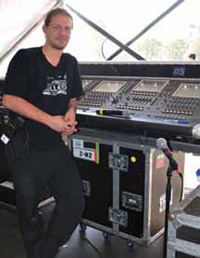A “Killer” Analyzer?

Harm Schopman, Monitor Engineer for The Killers, Puts Kaltman Creation’s Invisible Waves Analyzer to the Test
Harm Schopman, monitor engineer for The Killers, uses Kaltman Creation’s Invisible Waves Analyzer to cruise the wireless landscape in hectic settings.
Nothing can bring more stress to a monitor engineer than a poorly regulated RF environment, a faulty in-ear monitor, or issues with the output of an antenna. However, a product known as Kaltman Creation’s Invisible Waves Analyzer is gradually becoming an irreplaceable tool for those in charge of a wireless landscape, in need of the ability to identify these problems in hectic circumstances, like corporate events or other live settings.
On a daily basis, the Invisible Waves Analyzer provides me with the ability to walk in a new venue, fire up the laptop (I run my Invisible Waves software using Parallels on my Mac), and start scanning to see what the wireless environment looks like. First off, with the Invisible Waves components pre-configured in its carrying case, it’s really quick to set up. It’s a matter of connecting two cables (power and USB) and you’re set to go. The program adds some very nice user touches, too, like “profiles.” These enable me to quickly switch back and forth between four sets of frequencies, while doing the morning scan. It’s also useful to have the white space calculator quickly show me where there are useable gaps in the spectrum.
Aside from my normal setup, when I run into problems with antennae, cabling, or hardware units, the Invisible Waves is a godsend. I can quickly set it up so that it scans just what I want to look at, then change what I think is broken and measure for improvement.

The Invisible Waves Analyzer allows Schopman to run 10 monitored frequencies at once and to scan them quickly and continuously during soundchecks and the actual shows.
For example, one of our IEM units lost signal strength just before the band went on in Cape Town (isn’t that always the case?), but I was able to quickly determine that it wasn’t the cable or the antenna. This left the transmitter unit as the source of the problem, but we weren’t able to make the system work before the show. Instead, we quickly ran out a hardwire pack to one of the techs and worked around it. The Invisible Waves equipment had given us the measurement tools to determine what the problem was.
A daily selection of the top stories for AV integrators, resellers and consultants. Sign up below.
In Mexico I had a problem with one of our antenna cables. After measuring the output, we found it low compared to our normal level. My first attempted solution was to re-seat the antenna cable, but this lead to no improvement. When we replaced the cable we suddenly had full strength. Quantifiable, quick, and a far cry from the “try and listen” method that was used previously, the Invisible Waves once more identified our problem.
All in all, the Invisible Waves Analyzer is a remarkable tool for setup and trouble-shooting alike.
For more information on the Invisible Waves Analyzer, visit www.kaltmancreationsllc.com.
The AVNetwork staff are storytellers focused on the professional audiovisual and technology industry. Their mission is to keep readers up-to-date on the latest AV/IT industry and product news, emerging trends, and inspiring installations.
